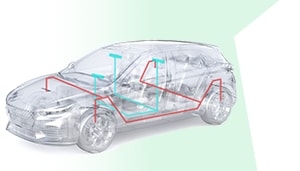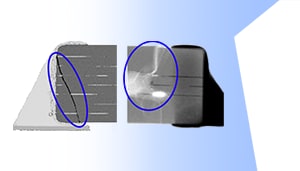|
 |
|
Common Mode Chokes and Chip Varistors for 10BASE-T1S |
While the development of next-generation vehicles for fully automated driving is gaining momentum, vehicle architecture is beginning to undergo major changes. Among them, the automotive network that connects ECUs responsible for advanced driver-assistance system (ADAS) is a very important element.
One particular focus is on automotive Ethernet for automotive networks, with 100BASE-T1 (100 Mbps) and 1000BASE-T1 (1 Gbps) for sensor systems in cameras, radar, and LiDARs. Furthermore, the 10BASE-T1S, a new standard for automotive Ethernet with a transmission speed of 10 Mbps, is gaining more attention.
Possible applications for 10BASE-T1S include actuator systems and sensors. |
|
 |
|
|
 |
|
Sensors for New Mobility |
The automotive production landscape is changing. The proliferation of electronic devices and sensors in modern car design has grown exponentially in recent years. It will expand further as the industry continues its transition toward e-mobility and autonomous driving. The core technologies featured in electric vehicles expand the realm into which sensors are deployed. Also, combustion engine vehicle gas sensors have shifted away from exhaust gas monitoring toward internal air quality (IAQ) measurement.
This article introduces how electrification and autonomous driving are expanding the role of sensor technologies within automotive designs. |
|
 |
|
|
 |
|
Failure Modes and Countermeasures in Actual Use of NTC Thermistors |
NTC (Negative Temperature Coefficient) thermistors are thermally sensitive semiconductor resistors which show a decrease in resistance as temperature increases, and its rate of change is extremely large.
Its main applications include temperature sensing in electronic equipment and temperature compensation for module products.
However, if the user misuses the product, it may not function properly and, in the worst case, this may cause malfunctions.
This page introduces the causes and countermeasures for ”cracks” and ”melting of ceramics” as failure modes caused by improper use of NTC thermistors. |
|
 |
|
|
 |
|
TDK TVS signal integrity for USB4® and Thunderbolt® 4 – protection of high-speed data lines and how to provide tailored ESD protection |
Universal Serial Bus (USB) is a well-established industry standard that has been in place for more than 20 years, defining the serial communication protocol and the connectors, cables, and chargers for battery-powered rechargeable portable devices. With each updated version of the USB, protocol data rates have continuously increased over the years. Today, we have USB4®protocol, with up to 40 Gbps data rates. Followed by the recently released USB Power Delivery (PD) charging protocol. This development meant a reduction in the time required for charging any peripheral device via USB plug, even though the battery capacities of peripheral devices have been increasing. The latest market developments pushing the technology trends to support requirements have been led by manufacturers’ offerings, followed by attempts to standardize the equipment used.
One of the widely used solutions that combines the
above requirements is the USB Type-C® connector, which supports up to 100 W power supply option. |
|
 |
|
|
|
 |
|
|

|
|
|